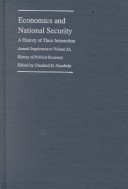History of Political Economy Annual Supplement
2 total works
Historically, economists have had very little to say about art: in the latter half of this century, that has begun to change. Difficult issues, like pricing and art valuation, the influence on pricing by what is fashionable in art, and the nature of the auction, have recently been tackled by economists in spite of elusive answers. Economic Engagements with Art suggests that taste and fashion in art need not be mysterious or outside rational discourse, and that they can be studied by economists to the great benefit of the discipline. This volume, which deals mostly with painting, is divided into three sections that consider the interplay between art and economics from different perspectives. In the first section, Art and Economic Theory, economists clarify the need to construct a framework for understanding the roles of taste and fashion in art valuation. A historical view is considered in a piece about the teacher of Velasquez and artistic adviser to the Inquisition in Seville, who took into account not only market factors, like demand, but also the "truth" and the nobility of the artist's profession and of the painting itself.
Also in this section is an essay on Rousseau's perspective on the worth of a painting based on its envy value in social circles; other contributions focus on William Stanley Jevons, a nineteenth century British political economist, whose problems with art stemmed from the uniqueness of each work, rendering definitive market and economic terms irrelevant. The second section of the book, Art and Economic Policy, looks at broader policy issues with regard to the historical role of art. Essays consider policy with respect to art exports and imports and federal patronage of the arts during the Depression; Lionel Robbins and the political economy of art; and the interplay among economy, architecture, and politics as shown in certain postwar Hilton hotels. In the final section, The Business of Art, a variety of perspectives are considered: the economics of art in early modern times, discussed in the context of both humanist and scholastic approaches; the pricing of pictures based on a study of the Smith-Reynolds connection; and the relationships between Otto Nuerath, graphic art, and the social order.
The first collaborative and historical treatment of the connection between art and economics, Economic Engagements with Art will appeal to people across, from history and economics to art history.
Also in this section is an essay on Rousseau's perspective on the worth of a painting based on its envy value in social circles; other contributions focus on William Stanley Jevons, a nineteenth century British political economist, whose problems with art stemmed from the uniqueness of each work, rendering definitive market and economic terms irrelevant. The second section of the book, Art and Economic Policy, looks at broader policy issues with regard to the historical role of art. Essays consider policy with respect to art exports and imports and federal patronage of the arts during the Depression; Lionel Robbins and the political economy of art; and the interplay among economy, architecture, and politics as shown in certain postwar Hilton hotels. In the final section, The Business of Art, a variety of perspectives are considered: the economics of art in early modern times, discussed in the context of both humanist and scholastic approaches; the pricing of pictures based on a study of the Smith-Reynolds connection; and the relationships between Otto Nuerath, graphic art, and the social order.
The first collaborative and historical treatment of the connection between art and economics, Economic Engagements with Art will appeal to people across, from history and economics to art history.
This is an examination of the interaction between economics and national security, which explores why the area of security studies has long been neglected by economists, even though defence and wartime expenditures regularly consume large portions of government income. The contributors demonstrate that the history of the relationship between economics and national security is far richer than previously thought. As a point of departure, the authors begin with the broad question of economists' neglect of national security and proceed to develop a series of hypotheses about why economists disengaged from this important collection of policy-relevant topics. The essays examine a number of traditions in economics (classicism, neo-classicism, Marxism) as well as the ideas of individual thinkers (Pareto, Pigou, Veblen, Hitler, Rostow).

